Wireless Broadband Internet ProvidersWednesday, 12-Nov-2014
Wireless Broadband is a rural-friendly technology offered by many small carriers across Canada:
| Carrier | Coverage Area |
|---|
| Xplore | Alberta, Winnipeg, Southern Ontario & Quebec, New Brunswick |
| Inukshuk | Yukon, NWT, Southeast Ontario, Southern New Brunswick, Western Nova Scotia |
| MCSNet | Edmonton |
| ABC Com | BC Interior, from Prince George to Kelowna |
| Other FWA | Varies from carrier to carrier |
Click any carrier above to see their sites on the Canada Cellular Services.
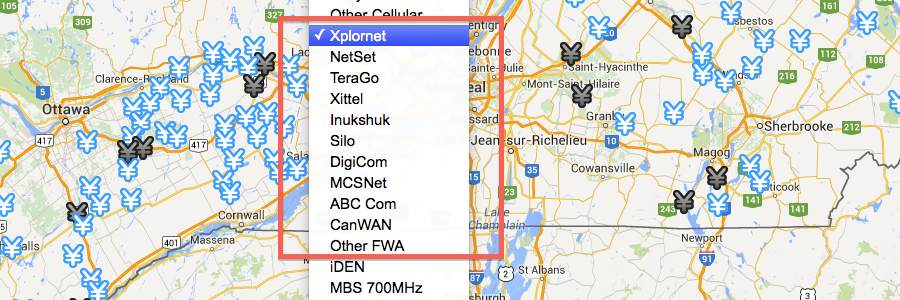
Wireless Broadband operates in the 3400 - 3700 MHz band, and provides 3 - 6 mbps bandwidth and 30 - 100 gigabyte caps.
Deployments are usually found in rural areas, cottage country or where the population density is too low to economically support cable, DSL or FTTx broadband service.
We also can generate wireless broadband site reports.
These report can include Statistics Canada population / census counts, to help you analyze site distribution against population, etc.
Frequency BandsTuesday, 28-Oct-2014
Carrier spectrum, auctioned by Industry Canada for billions of dollars, is divided into frequency bands:
| Band Name | Abbrev | Frequency |
|---|
| Mobile Broadband Services | MBS | 700 MHz *NEW* |
| iDEN | IDEN | 800 MHz |
| Cellular | CELL | 850 MHz |
| Personal Communications Services | PCS | 1900 MHz |
| Advanced Wireless Services | AWS | 2100 MHz |
| Broadband Radio Service | BRS | 2500 MHz |
| Wireless Communications Service | WCS | 2300 MHz |
| Fixed Wireless Access | FWA | 3500 MHz |
These frequency bands now appear under the Bands column of the Address tab:

The Bands column gives you a quick summary of what's available, without having to scan the long list of frequency information provided under the Antenna tab.
Videotron LTEWednesday, 22-Oct-2014
The new Videotron LTE filter gives you access to the long awaited Videotron LTE network, and its 333 LTE cell sites across the province of Quebec and the Ottawa region.
Here's their coverage in the Montreal area:
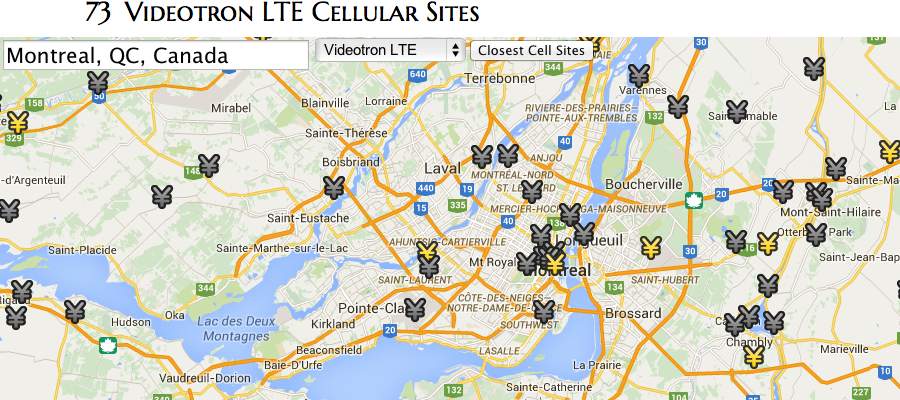
Videotron's LTE coverage serves nearly 90% of Quebec's population.
In addition, they announced an agreement with Rogers to bring LTE to even more customers.
Growth of Canada's 700MHz NetworkMonday, 29-Sep-2014
Last month, we began mapping Canada's 700MHz network.
At that time, this network was mostly situated east of Sault Ste. Marie:
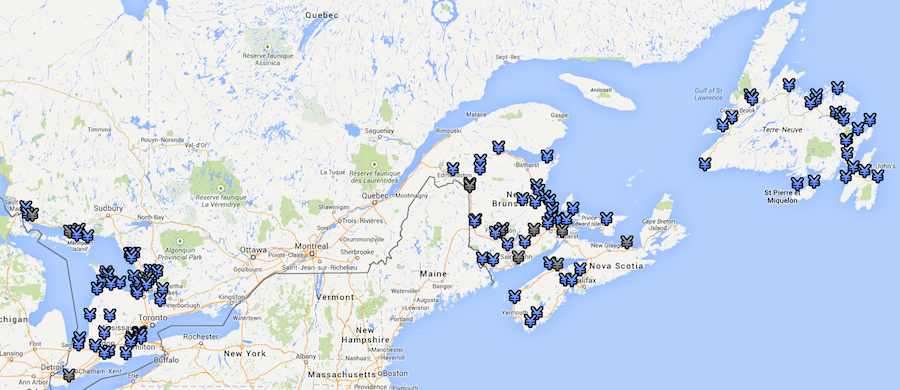
Today, we see that this network has more then doubled in size (256 vs 124 sites), but still resides almost entirely east of Sault Ste. Marie:
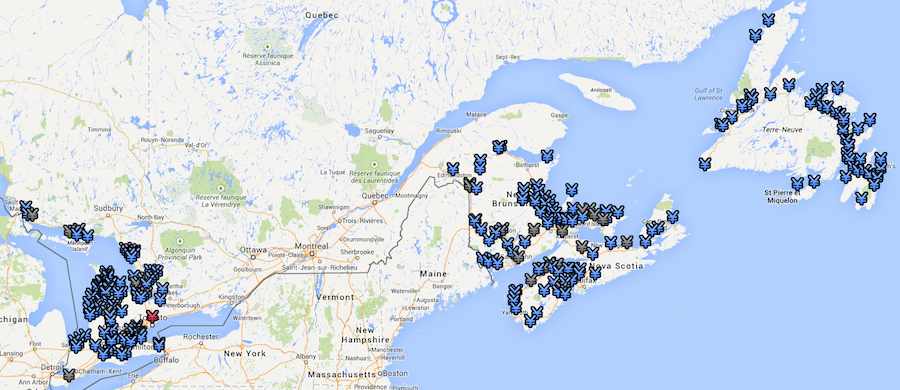
And, if you look closely you'll see Rogers' first 700MHz site (in red) in the Toronto area.
Google Earth Integration — KML ExportWednesday, 17-Sep-2014
The Cellular Site KML Export feature now exports customizable cellular signal beams.
When viewed in the 3D environment of Google Earth, these signal beams can help you identify cellular site coverage areas and RF shadow areas, especially around remote drilling locations, mountainous areas and valleys.
The beams are customizable via the Length of beam and Width of beam parameters.
In the example below, we are requesting beams to be drawn 5km in length, with a width of 15 degrees:

Google Earth organizes the exported KML file into left and right panels.
The left panel displays a list of carriers and the frequency bands present at the cellular site.
Each combination of "carrier + frequency band" corresponds to one or more beams shown in the right panel.
Check boxes let you control the visibility of any beam.
Carrier assigned site codes are shown next to the carrier name (where available).
The right panel shows the beams, colored with the same scheme used by the Canada Cellular Services.
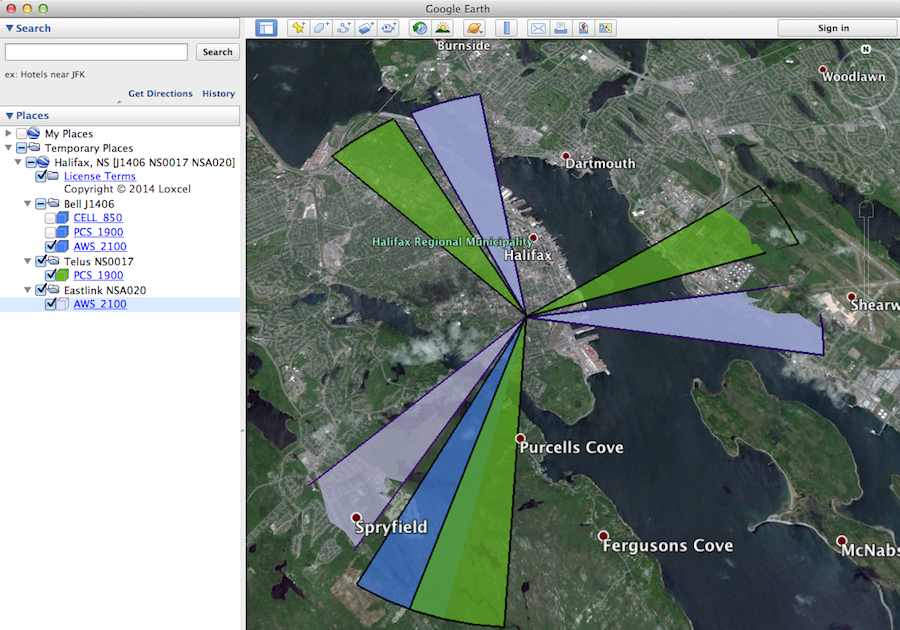
Click a beam to see its antenna details:
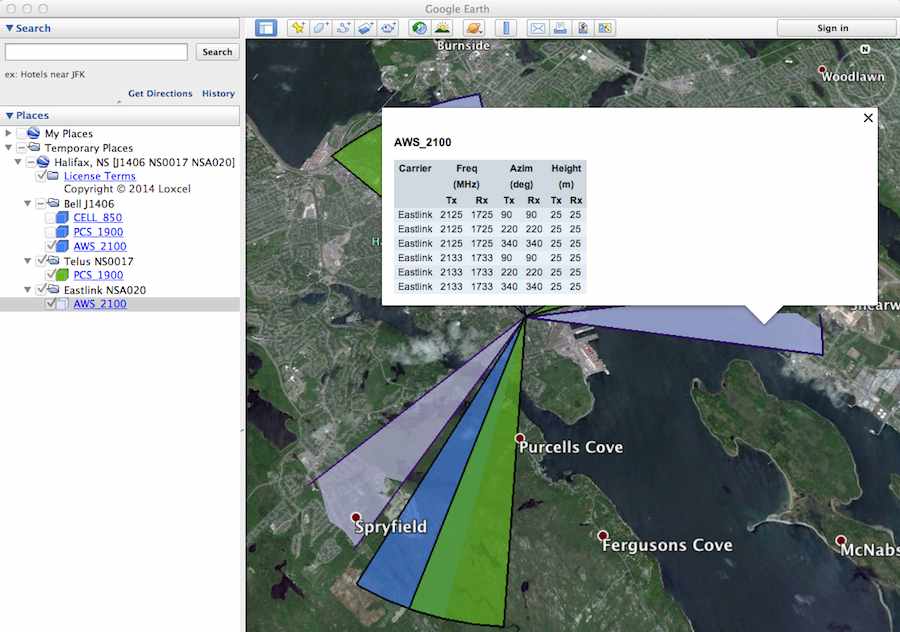
Topographic Graph AngleFriday, 22-Aug-2014
Subscribers of Canada Cellular Services have been putting the topographic graph to good use:
I found the topographical graph (with the elevation) very useful ...
For companies that offer booster and tower solutions, it seems very helpful in determining any extra requirements or parts for the installation.
It can potentially help to avoid on-site visits and consultation.

They recently asked for a way to measure the angle from their location (at the left) to the steepest peak.
So, we added a blue dashed line (shown above) that shows this angle.
Note that the steepest peak is usually but not always the highest peak.
Are you wondering why the 2° angle appears so steep?
The graph's x and y axes scale independently, to allow hills and mountains to stand out.
The angle's rise is only 120m, but its run is 4,500m, for a slope of 0.0267.
The inverse tangent of 0.0267 is 1.53°, which when rounded to a whole number, equals 2°.
If you need assistance with this or any other feature of the Canada Cellular Services, please contact us.
To support topographic visualization, the map now has a Terrain control:
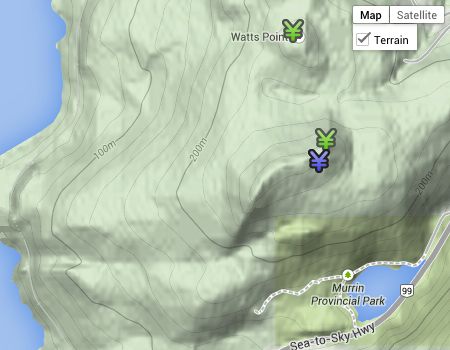
700MHz BandThursday, 21-Aug-2014
The Canada Cellular Services and Mobile App now include coverage of the new 700MHz band.
The MBS 700MHz filter, highlighted in red below, currently shows 124 cellular sites across Ontario, New Brunswick and Newfoundland.
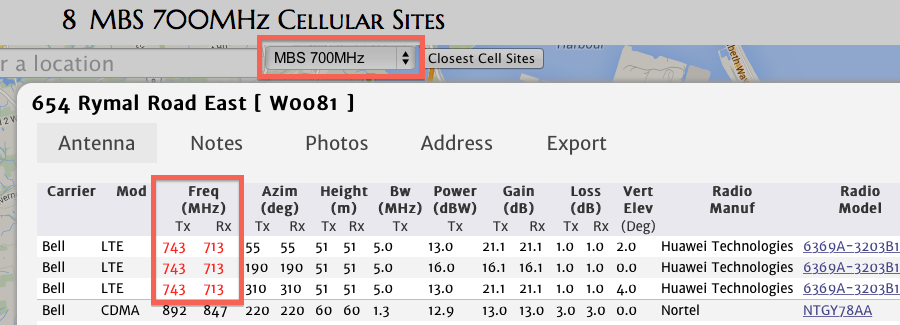
Together, these 124 sites contain 787 antenna that transmit at 737MHz or 743MHz, and receive at 707MHz or 713MHz, with a bandwidth of 5MHz.
The 700MHz band, previously used for UHF TV broadcasts (channels 52 - 69), was recently reallocated by Industry Canada for Mobile Broadband Services (MBS).
Eight Canadian companies paid $5.27 billion to purchase 98 licences, comprising 68 MHz of spectrum, divided into seven licence blocks across 14 service areas.
Site Topographic GraphFriday, 27-Jun-2014
Signal strength depends on many factors, including antenna aim-back, and topography.
This example shows four Rogers LTE antenna 31.4 km away, with two providing Med-Strong aim-back:

We recently added a topographic graph (shown in green) that plots elevation between your location (on the left) and the cell site (on the right).
Even with med-strong aim-back, cellular reception will not be observed in the example above, due to multiple, intervening 1,000m high mountain ranges.
In contrast, the example below shows strong aim-back and a clear line-of-site, across relatively flat terrain.
These conditions almost guarantee some cellular reception.

Note: The topographic graph is available with Firefox, Safari, Chrome and Internet Explorer 9 or above.
Launch Site Finder from Android HomescreenThursday, 12-Jun-2014
Our Cellular Site Finder application is popular with Android smartphone users.
Follow these five easy steps to make it accessible from your homescreen, and launch with a single tap:
Step 1: Launch Chrome
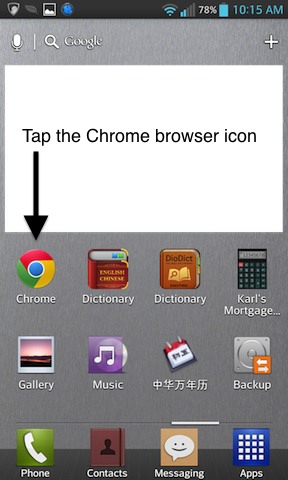
Step 2: Enter URL
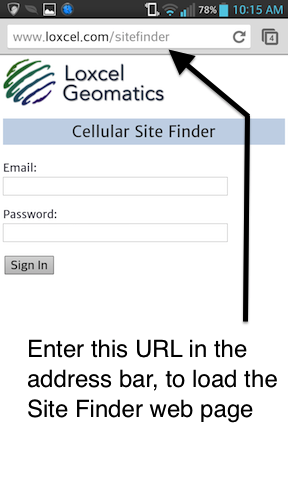
Step 3: Add to Homescreen
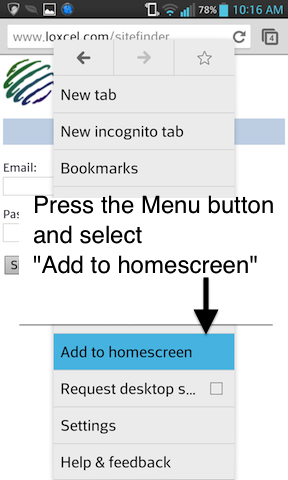
Step 4: Enter Title
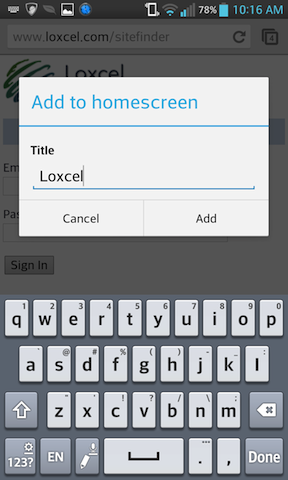
Step 5: Launch from Homescreen
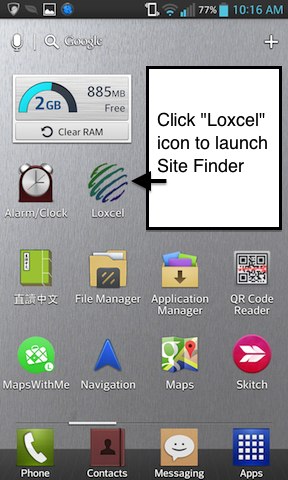
With one tap on the Loxcel icon, you have immediate access to the Cellular Site Finder application.
Telus UpdatesWednesday, 23-Apr-2014
Canada Cellular Services receives regular updates, from many sources including
- carriers,
- our internal team of data specialists,
- government agencies,
- clients (aka. Data Detectives), and
- our extensive data archives.
Today's updates include a significant refresh of information for Telus.
This includes 184 updated sites, and 9,718 channels.

We are thankful for our close working relationships with the federal government and carriers, which we work with to resolve quality issues.
We are also thankful for our relationship with an increasing number of users and subscribers.
These Data Detectives provide us with feedback regarding missing sites, and contribute site photos, accessible from the Canada Cellular Services.
Launch Site Finder from iPhone HomescreenTuesday, 8-Apr-2014
Our Cellular Site Finder application is popular with iPhone and iPad users.
Follow these four easy steps to make it accessible from your homescreen, and launch with a single tap:
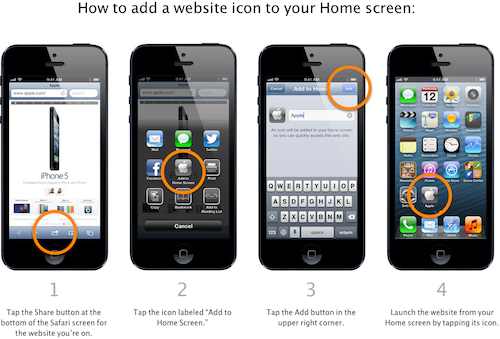
With one tap on the Loxcel icon, you have immediate access to the Cellular Site Finder application.
Coffee BreakMonday, 7-Apr-2014
To celebrate the start of another week, we offer you our Starbucks store locator.

Enjoy!
Big3 FilterFriday, 4-Apr-2014
Filters let you view cellular sites by carrier, band or modulation technology.
The Canada Cellular Services has 11 carrier-related filters, one for each of the 11 largest national and regional carriers across Canada.
Big3 is a new carrier-related filter that shows Rogers, Bell and Telus — the Big Three Carriers — at the same time.
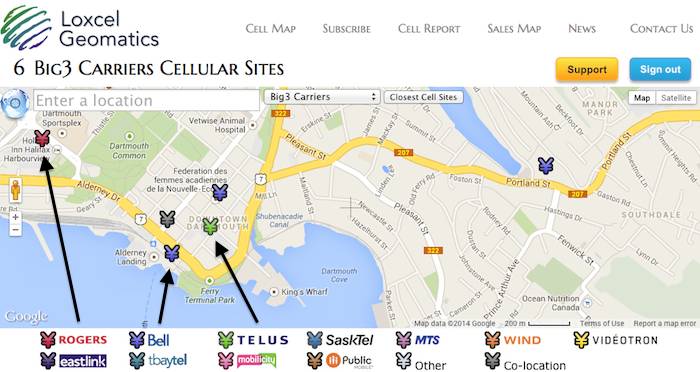
When Big3 is selected, the map will show only Red, Blue, Green or Grey icons, corresponding to Rogers, Bell, Telus or co-location sites respectively.
Carrier GrowthWednesday, 2-Apr-2014
There are many ways to observe the growth of Canadian carriers.
You can examine figures published by the Canadian Wireless Telecommunications Association (CWTA),
coverage in The Globe & Mail
or a news release by Industry Canada.
Another way is to look at the channel counts for each carrier.
We count channels — not sites — because it's the antenna and not the sites that handle subscriber traffic.
The graphs below show this growth from July 2013 to today.
We separated the national carriers from the regional carriers because the 10:1 ratio in channel counts between them would relegate the regional carriers to the bottom
crust of a shared graph.
National Carrier Channel Counts
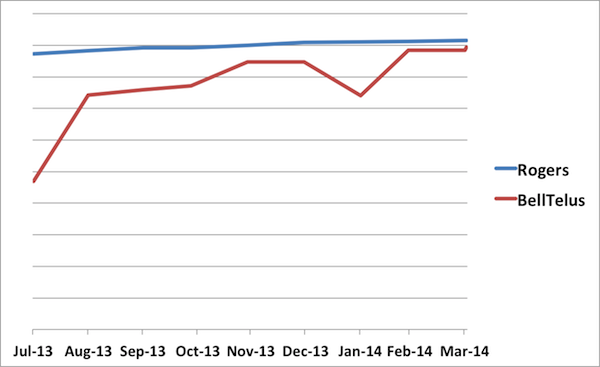
(Bell and Telus' channel counts are merged because they share infrastructure.
The blips for BellTelus in Jul 2013 & Jan 2014 are due to filing issues with Telus and Bell, respectively.)
Regional Carrier Channel Counts
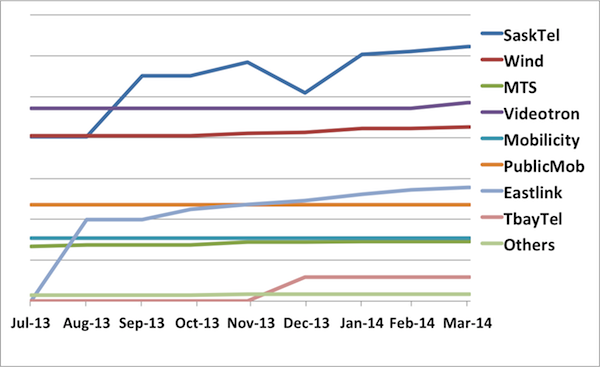
(Tbaytel did not begin reporting until Dec 2013.)
For more details and statistics, please visit here.
And to see all these antenna — and much more — please visit here.
Center Map on Your Current LocationWednesday, 12-Mar-2014
The Canada Cellular Services can now sense your location, and center its map on your current location.
To begin, click the blue globe icon in the top-left corner of the map.
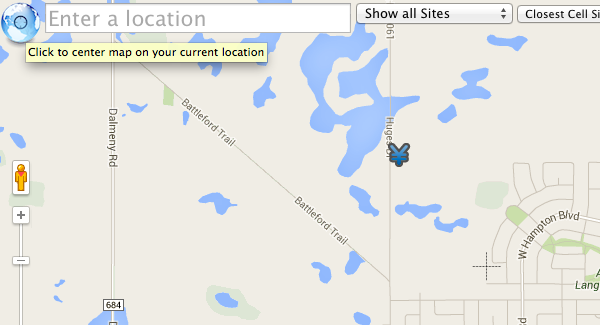
As a security measure, the browser will first ask your permission, before sensing your location.
Positional accuracy depends on the method the browser uses to sense your location.
For example, if you are accessing the web through a wifi connection, the browser will use the location of your wifi router, which offers accuracy under 1km.
Center Map Using Alberta Township System (ATS)Thursday, 20-Feb-2014
You now have three ways to center the Canada Cellular Services map:
- Latitude / longitude,
- City, street or other place name, and
- Legal Subdivision (LSD) / Quarter Section, within the Alberta Township System (ATS). ** NEW **
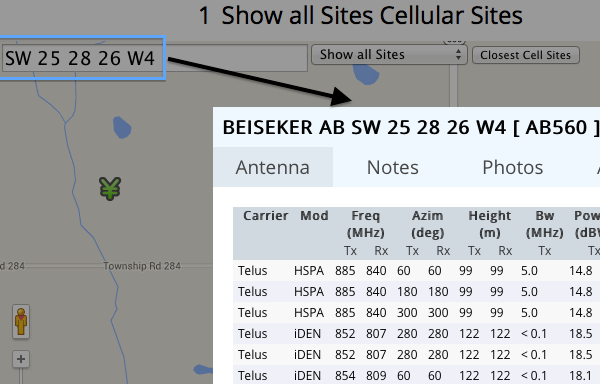
LSD and quarter sections are accepted in these formats:
- 5 10 15 20 W4 — LSD 5, section 10, township 15, range 20, west meridian 4
- SW 10 15 20 W4 — South-west quarter of section 10, township 15, range 20, west meridian 4
According to the Professional Petroleum Data Management (PPDM) Association:
The Unique Well Identifier, although based on the legal survey position of a well, is primarily for identification, rather than location. The location component describes a small land area, not the exact position of the well.
Please visit this link for more information.
Cellular Services Mobile AppMonday, 10-Feb-2014
We're pleased to announce the availability of our mobile app for iOS, Android and Windows Phone.
This app includes the powerful Closest Cellular Sites feature from our desktop Cellular Services product.
In addition, it can use your phone's GPS to show cellular and wireless broadband sites closest to your current location.
There is nothing to install.
From your smartphone's browser, simply visit
Canada,
Australia or
New Zealand
Mobile App, and you're ready to go.
These four screen shots show the progression through the app (starting from the left):
Sign In -> Enter Your Location -> List of Sites -> Site Details.
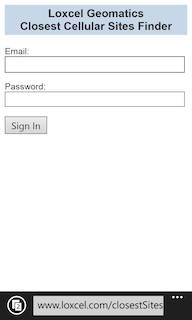
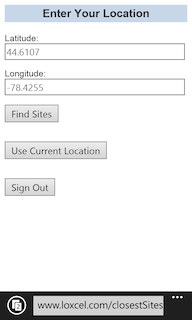
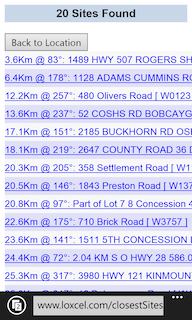
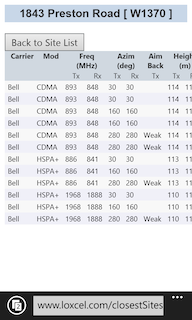
Sign with the same email and password you use to sign in to the desktop product.
Click Use Current Location from the Enter Your Location screen to populate latitude and longitude fields with your current location.
Changes to Canada's Antenna Tower Siting PolicyWednesday, 5-Feb-2014
Earlier today, James Moore, Minister of Industry, announced changes to Canada's Antenna Tower Siting Policy that will require companies
to consult with local citizens before a tower is built.
Previously, companies only needed to consult when they were planning to build a tower higher than 15 metres.
Now, they'll be required to consult on all new towers, regardless of height.
In the past, there was no limit to the length of time companies could wait before they built a new tower.
Now they will be required to build the tower within three years of consulting with residents.
In addition, companies will be required to better inform community residents of upcoming consultations, so that they can have their say.
In the past, a resident might have received an un-addressed flyer or letter in the mailbox and easily confused it with junk mail.
Under the new rules, companies will need to make sure this type of mail is clearly marked.
They also announced changes to strengthen federal communications with the public on tower siting procedures.
This will include new simple online resources on the process and new reporting mechanisms to track tower issues and report back to communities.
Municipalities across Canada use our online tools and reports to develop tower siting protocols. Please contact us to learn how we might be able to assist you.
Ref: speaking points.
# People / Cellular SiteWednesday, 22-Jan-2014
This story is an update to a story from six months ago, which graphs cellular site density across Canada's largest cities.
This time we increased our coverage to include Canada's 30 most populous cities.
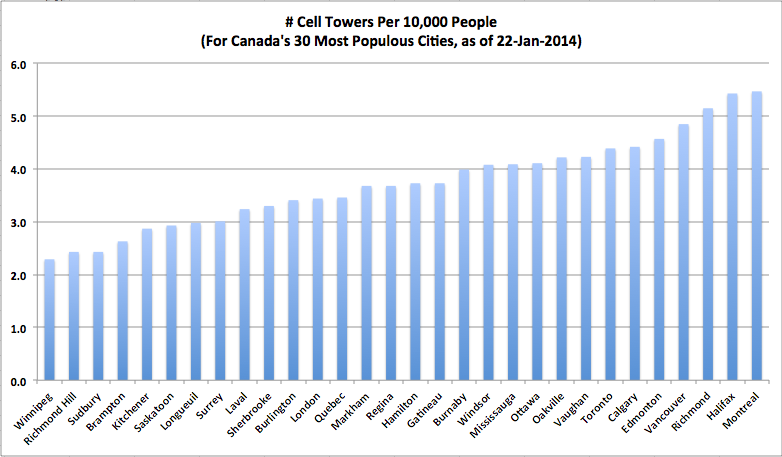
Compared to six months ago, Winnipeg and Montreal remain on either end of the graph.
And, as we predicted, changing usage patterns supported by gigabyte smartphone data plans produced a 10-20% gain in site density across all cities.





























